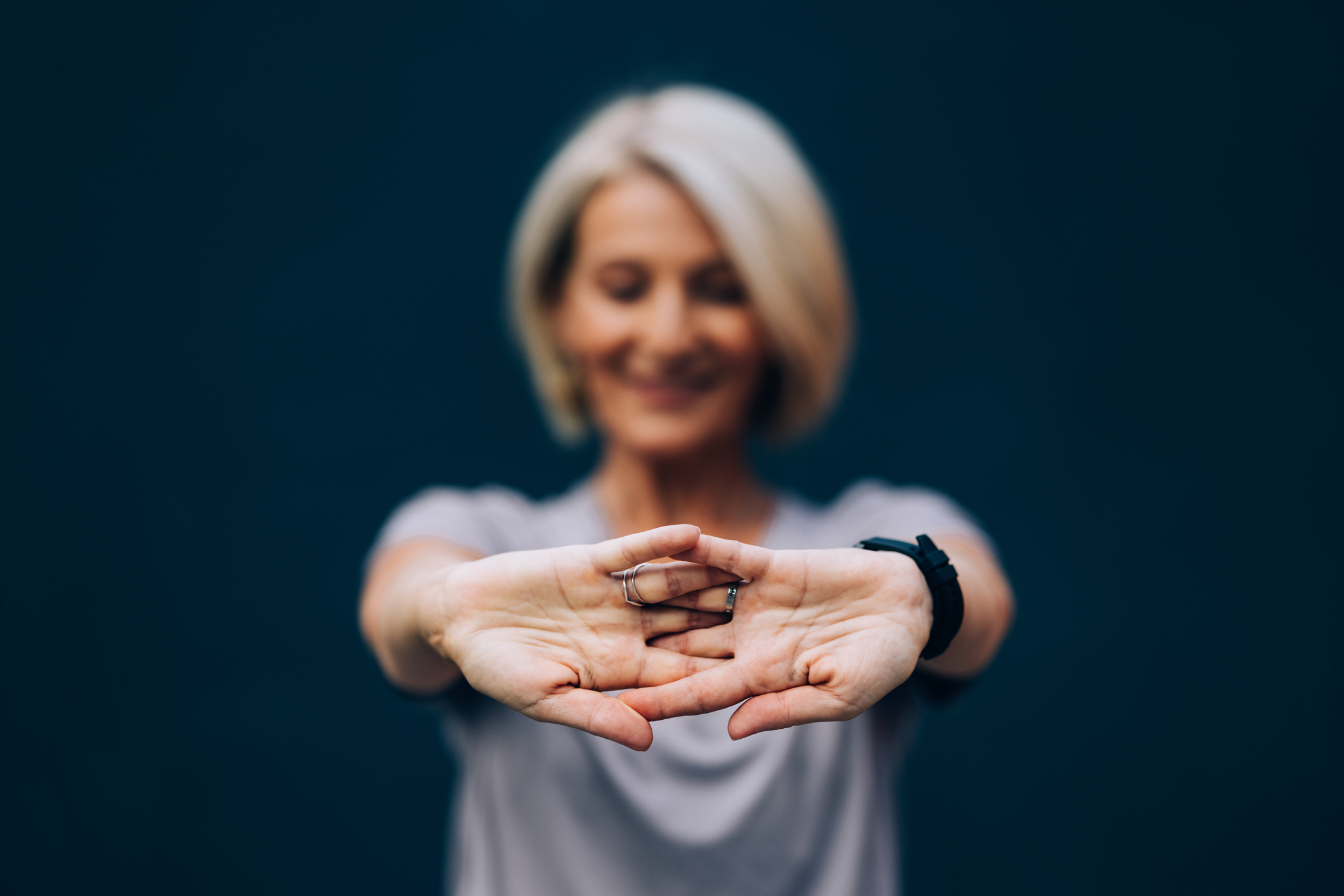Navigating the Change – Holistic Wellbeing During Menopause

You’re giving an important presentation. Suddenly, you feel the familiar creep of a hot flush. You feel sweaty, flustered and embarrassed. Later that day, you struggle to focus because you didn’t sleep well and your brain feels foggy. Your anxiety levels rocket, and you become stressed and snappy with your family that evening.
If you’re going through the menopause, this probably sounds familiar. You’re not alone! In fact, an estimated 8 out of 10 menopausal women are working. If you’re one of them, you’ll know how this major life transition affects many aspects of your wellbeing and performance. That’s why a holistic approach is needed.
Understanding menopause
Before delving into coping strategies, let’s start with the basics.
If you haven’t had a period for 12 consecutive months, you’re officially in menopause. It’s driven by a sudden decline in oestrogen, progesterone and to a lesser extent testosterone. The average age to experience a natural menopause is 51, but medical interventions can trigger an earlier transition.
Perimenopause refers to the years leading up to menopause, often beginning in your forties. Menopause symptoms start to occur during this time, but a lack of awareness means that they’re often dismissed or attributed to something else.
Recognising the signs
The bad news is there are 34 recognised menopause symptoms. The good news is you won’t experience all of them! We’re all unique, some women sail through it, while others find it more difficult.
So why do symptoms occur? Plummeting oestrogen and progesterone are mostly to blame.
Oestrogen, in particular, affects your menstrual cycles, mood, skin, hair, blood vessels, mucous membranes and urinary tract, so when it declines the impact can be huge. It also has a protective effect on your heart, mental function and bones.
When your ovaries no longer produce oestrogen and progesterone, you may notice some of these symptoms:
- Hot flushes
- Night sweats
- Brain fog and forgetfulness
- Changes to skin and hair
- Low libido and painful sex
- Weight gain
- Anxiety and low mood
- Palpitations
- Sleep disturbances
Some of these mirror other, more serious conditions, so pay your doctor a visit just in case.
A holistic approach
As menopause can affect so many areas of your wellbeing and performance, the afore-mentioned holistic approach is needed. This is where the Hintsa Circle of Better Life methodology comes in. Let’s take a look at each element in turn.
1. Core
Perimenopause and menopause can create a loss of identity, purpose, and control – at Hintsa we call these elements the ‘Core’. You may feel that things are happening “to” you, like you’re no longer in the driving seat of your own life.
For example, moving from a time of fertility to a time where you’re no longer able to conceive – even if you don’t want more kids – can create mixed feelings. You’re also moving into the second half of your life, and it may look different than you had imagined.
It can be helpful to practise some reframing during this time. Ask yourself questions like:
- Who was I before, who am I now and who do I want to become?
- What control can I create over life changes?
- What/who is important to me right now?
- What do I want to achieve in the second half of my life and how does this reflect my values? How will it give me purpose and meaning?
2. General health
Fluctuating hormone levels can have a lasting impact on your overall health and longevity.
For example, did you know that the number one cause of death worldwide is heart disease? Oestrogen has a heart-protective effect, so when it declines you’re more at risk. Getting regular exercise, maintaining a healthy weight and eating a balanced diet are key.
You’re also at increased risk of osteoporosis during and after menopause, which can lead to fractures. It’s worth getting regular bone density scans to monitor this – exercise can help to maintain bone strength and so can taking calcium.
As if this weren’t enough, urinary incontinence and sexual dysfunction increase due to the drop in protective oestrogen and thinning of vaginal skin, as well as weakening pelvic floor muscles.
It’s not all doom and gloom. Many women swear by Hormone Replacement Therapy (HRT) for relieving a whole host of menopause symptoms. It also has a protective effect on heart, bone and brain health. Deciding whether to take it is a personal decision, but there’s a lot of current research to support the safety of its use under medical supervision.
If you do decide to take HRT, it’s still important to embrace a holistic approach to managing your symptoms and navigating this new phase in your life.
3. Sleep & recovery
During menopause, disrupted sleep can impact your circadian rhythm (your body clock). Progesterone is a natural sedative, so when it declines your sleep can suffer – if you’re feeling anxious this can also make it harder to drift off. A few tips to consider:
- Implement consistent sleep/wake times to reset your circadian rhythm (yes, even at weekends!)
- Enjoy a relaxing bedtime routine, keep it the same every night so that it cues your brain to feel sleepy
- Keep your room cool to help with night sweats/hot flushes, have a towel and a fan on standby.
- Consider Cognitive Behavioural Therapy (CBT), acupuncture, yoga and meditation to help you unwind
- Magnesium can help with sleep and research shows that it’s beneficial to the heart, bones, muscles and nerves. The Recommended Daily Amount (RDA) for women is 310-320mg.
4. Mental energy
Do you ever walk into a room to get something, then walk straight back out because you’ve forgotten what it was? Or struggle to find the right word or phrase during an important meeting?
Don’t worry, you’re not going mad! This – along with difficulties in focusing – is known as ‘brain fog’ and it’s thought to affect around 60% of menopausal women.
If you enjoy things like reading, playing board games, cards or puzzles, then staying mentally sharp can be literally fun and games. A recent study showed that cognitively stimulating activities can potentially delay the onset of dementia, but they can be helpful even if you start years earlier.
Implementing routines during this time can be useful, as this helps with feelings of control as well as minimising mental load.
A recent 2021 study showed that creatine may have positive effects on mood and cognition by supporting brain health, especially in women who are menopausal and at an increased risk of inflammation.
Mental fatigue can also be common at this time, especially if you’re not sleeping well. Short naps can really help, but if this isn’t possible try non-sleep deep rest, which is where you deliberately relax for a set amount of time – meditation and gong baths are great for this.
Exercise can also perk you up, but if you’re too tired try moving your physical activity to a time feel most energised – for most people this is often the morning.
5. Nutrition
This is a time to get back to basics when it comes to nutrition. Minimising inflammation and keeping blood sugar stable throughout the day is the aim.
Staying hydrated, especially during the summer, is crucial. As we age our ability to sense thirst may become less sensitive, so keep sipping throughout the day.
Top tips for a healthy menopause diet:
- Opt for lots of wholegrains, fruit and vegetables
- Try to limit refined carbs e.g. white bread, white pasta and biscuits/cakes/crisps (sorry!)
- Ensure you’re eating enough protein for your weight and activity level to maintain and build muscle
- Fill up on healthy fats, especially omega 3 fatty acids which can increase blood flow in the brain, boost learning and improve cognitive health. Oily fish or flax seeds are good sources
- Eat plenty of antioxidant rich foods to help rid your body of free radicals – look for brightly coloured fruit and vegetables, variety is key!
- Limit salt and avoid processed meats, sugary drinks and fried foods
6. Physical activity
During menopause, you might find that your previous fitness routines aren’t as effective. We all lose muscle as we age, but it becomes more pronounced at this time. That’s why a shift toward muscle-building activities becomes beneficial. The more strength training you do, the stronger you’ll be!
Building/maintaining muscle will result in better body composition, metabolic benefits, heart health, bone density and brain function. You could use weights and machines, but if you don’t fancy the gym there’s lots you can do at home – try exercise bands or even simple push-ups or planks. Scatter them through the day if you don’t have a lot of time, it all counts!
From a cardiovasuclar perspective, remember that regular brisk walks have multiple benefits including boosting your mood, increasing stress resiliency (through suppression of cortisol), protecting heart health as well as decreasing menopausal symptoms.
7. Biomechanics
Are you a bit stiffer or more achy lately? When oestrogen declines, you’ll have less collagen in your tendons and ligaments. As a result, without regular mobility work you can lose important functionality. They don’t say ‘motion is lotion’ for nothing!
Look for opportunities in your day to add small stretching breaks, especially before sitting down to work, watching TV or going to bed to help keep your joints and muscles mobile.
Silver linings
There’s no doubt that menopause can be a challenging transition, but it’s worth bearing mind that it’s just that – a transition.
The symptoms can last a few years if you’re not taking HRT or you don’t make positive lifestyle changes, but they will eventually pass. There are many benefits to ageing, including the wisdom that comes with life experience, better decision making and the chance to reflect on what you want out of the next phase of your life.
Menopause is a bridge from one half of your life to the other. There’ll be bumps in the road, but taking a holistic, self-compassionate approach means you’ll emerge far stronger on the other side.



